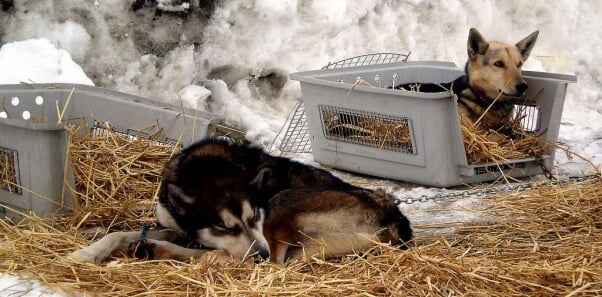You Won’t Believe What Happens to Dogs on the Iditarod Trail
The Iditarod dogsled race is an annual event during which human sled drivers, called “mushers,” are pulled through the frigid Alaskan wilderness by a team of up to 16 dogs. The exact path they take, from Anchorage to the town of Nome, varies slightly from year to year, but the course length is unofficially listed as 1,049 miles—about the distance from Memphis, Tennessee, to New York City.

This grueling race has proved deadly to dogs for many years. Dog deaths are so common during the race that Rule 42 of the official Iditarod rules blithely acknowledges that some dogs’ deaths may be considered “unpreventable.” How then, in good conscience, in 2017, can an event known to cause animals to suffer and die be celebrated?
As the 2017 Iditarod approaches, it’s important to remember the dogs who are injured and killed as well as disturbing facts about the race:
- At least 27 dogs used in the Iditarod have died just since 2004. In 2016, Nash died after being hit by a snowmobile during the race. In 2015, dogs Stiffy and Wyatt both died on the trail, and a dog named Stuart got loose and was later hit by a car.
- Countless dogs are injured. In 2015, they included dogs used by musher Yuka Honda, who crashed into a sled and was then run over by another–and Laura, a 5-year-old dog who, according to news reports, was essentially “blind” and often seemed “confused” but was forced to race anyway by Kelly Maixner.
- Dogs used in the Iditarod are forced to run up to 100 miles a day through biting winds, blinding snowstorms, subzero temperatures, and treacherous ice. Even with snow booties on some, the dogs’ feet can become cut, bruised, and raw from the vast distances of frozen terrain that they cover.
- The official Iditarod rules require only that the dogs be provided with a total of 40 hours of rest—even though the race can take up to two weeks. Most states have laws that prohibit overdriving or overworking animals, but Alaska does not.
- Dogs suffer out of sight off the trail, too. The vast majority of dogs used in sledding are kept chained up, with only overturned barrels or dilapidated doghouses for shelter. Dogs who aren’t the best runners are often treated like defective equipment. Dogs have been beaten, shot, abandoned to starve, or left at already overburdened animal shelters.

- Official race rules actually forbid mushers from saying anything negative about the race—and not just during their run but for an additional 45 days after they’ve crossed the finish line. Recent years have brought poor (and dangerous) trail conditions that posed a significant risk of injury to both humans and canines involved in the race, and this gag order has likely been placed in an attempt to keep concerns about such issues quiet. In their own words, Iditarod organizers declared that mushers “shall not make public statements or engage in any public conduct injurious to and in reckless disregard of the best interests of the Race. This includes public statements or acts which are disparaging to any of the sponsors of that year’s Race.” With rules in place to protect financial sponsors, it would appear that the business interests of race organizers trump concern for the health and safety of the dogs being used in this deadly event.
Dogs deserve far better than a lifetime of isolation, cruelty, suffering, and death on the Iditarod trail.
Animals all over the world continue to suffer in cruel, archaic “sporting” events. Whether in a bullfighting ring in Spain or on a trail through the Alaskan wilderness, animals’ lives should never be at stake for human entertainment.
Share this piece with your family and friends: Let them know that dogs should never be seen as disposable pieces of sporting equipment. They belong indoors, as members of the family.



